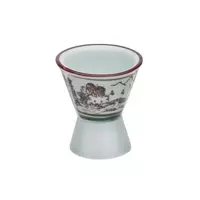To saca

In Japan, where sake is a traditional alcoholic drink, it is called nihonshu, but in everyday life, the words o-sake or sake mean any type of alcoholic drink, so this name has taken root in other languages. In the sake taste, pleasant bitter or sherry tones, notes of grapes, bananas or apples may be present (and this is despite the fact that it is made from rice). The best varieties of sake are characterized by the taste of ripened cheese, fresh mushrooms or soy sauce. The color of this drink can be from colorless (transparent) to yellowish-amber or greenish-lemon.
Drinking sake is accepted not only cooled to five degrees, but also heated - up to 60 ° C. The main rule of drinking this Japanese drink remains unchanged - a good sake should be drunk cold, and a bad one should be drunk warm. This is due to the property of sake to blunt its taste and aroma when heated, so a low-quality drink is recommended to be heated. In addition to direct use in its pure form, sake is also used for culinary purposes, where it is used to eliminate unpleasant odors.
Sake species
In our country, among the numerous species of sake, only a few are the most common. In particular, Sake Fukushu, which has a strong strength (75%) and Sake Tokutei Meishoshu, a premium drink (25% alcohol).
In addition, Sake Honjōzo, which contains a small amount of distilled alcohol to soften taste, is also a fairly popular type of sake. Sake Jummai is characterized by 100% pure rice sake without any additives.
Two more types of sake that can be purchased in domestic stores also stand out - the sake Ginjo and the sake Daiginjo. The first is characterized by a rather pleasant floral and fruity aroma and delicate taste, and for the preparation of the second, the highest quality rice varieties are used exclusively.
Composition sake
It is known that sake includes rice, where it acts as the main component. However, despite the fact that this drink is most often called rice vodka, this statement is fundamentally wrong, since sake production does not use distillation, but pasteurization of raw materials.
Sake is often called rice wine, which is also wrong, due to the fact that mold fermentation, not fermentation, is used according to the technology of preparing this strong drink.
In fact, sake is nothing more than rice beer, the strength of which can be different. So, sake includes rice malt, steamed rice and water.
sake 134 kCal
Energy value of sake (Ratio of proteins, fats, carbohydrates - ju):
Proteins: 0.5 g (~ 2 kCal)
Fats: 0 g (~ 0 kCal)
Carbohydrates: 5g (~ 20kCal)
Energy ratio (bj | y): 1% | 0% | 15%
 Español
Español Français
Français Português
Português Русский
Русский 简体中文
简体中文 繁體中文
繁體中文 日本語
日本語 한국어
한국어 العربية
العربية Türkçe
Türkçe Қазақ
Қазақ Deutsch
Deutsch Italiano
Italiano Українська
Українська
